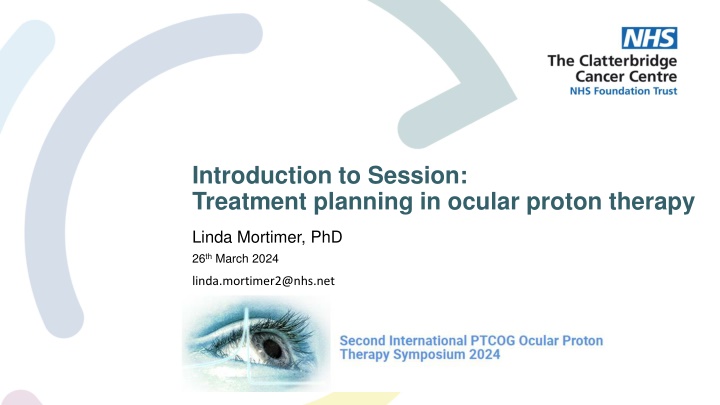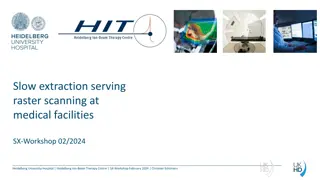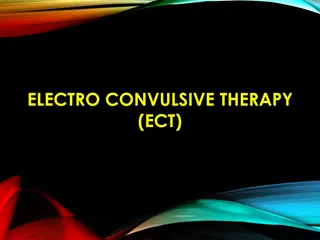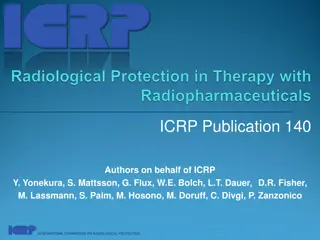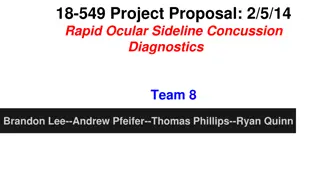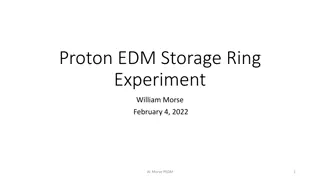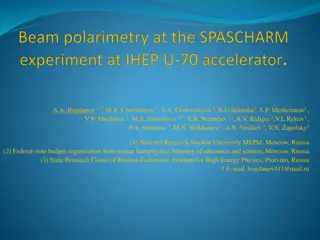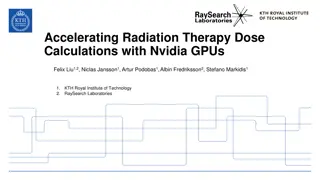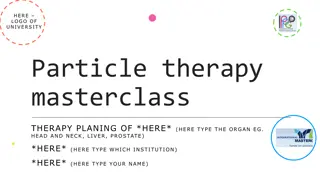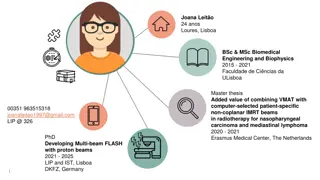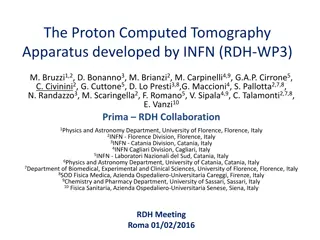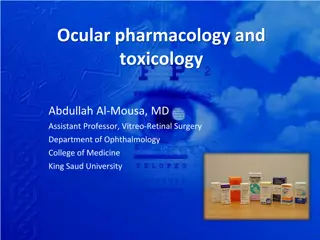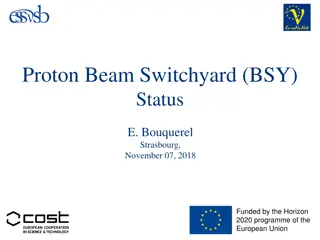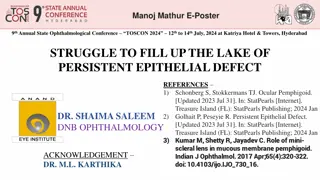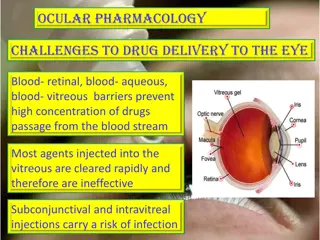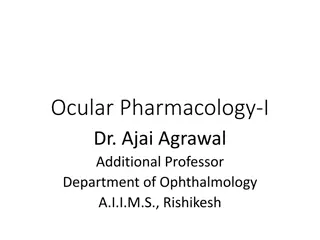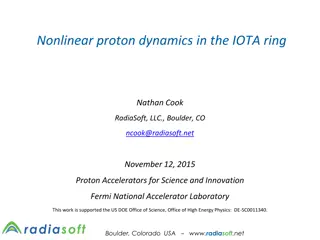Advances in Ocular Proton Therapy Treatment Planning
Explore the intricate world of ocular proton therapy treatment planning with Dr. Linda Mortimer, PhD. Discover the fundamental elements of an ocular treatment plan, main goals of treatment planning, an overview of dedicated ocular Treatment Planning Systems (TPS), planning workflows, choice of TPS, and insights into the future of treatment planning in Optical Proton Therapy (OPT).
Download Presentation

Please find below an Image/Link to download the presentation.
The content on the website is provided AS IS for your information and personal use only. It may not be sold, licensed, or shared on other websites without obtaining consent from the author.If you encounter any issues during the download, it is possible that the publisher has removed the file from their server.
You are allowed to download the files provided on this website for personal or commercial use, subject to the condition that they are used lawfully. All files are the property of their respective owners.
The content on the website is provided AS IS for your information and personal use only. It may not be sold, licensed, or shared on other websites without obtaining consent from the author.
E N D
Presentation Transcript
Introduction to Session: Treatment planning in ocular proton therapy Linda Mortimer, PhD 26th March 2024 linda.mortimer2@nhs.net
Acknowledgements Kees H. Spruijt, HollandPTC Mario Ciocca, Fondazione CNAO (Pavia, Italy) Jan Swakon & Tomasz Horwacik, CCB / IFJ Jens Heufelder, HZB/Charit Jan Hrbacek, CPT PSI Andrzej Kacperek, University College London, UK
Scope 1. Elements of an ocular treatment plan 2. Main goals of ocular treatment planning 3. Overview & comparison of (dedicated) ocular Treatment Planning Systems (TPS) 4. Planning workflow: traditional & modified (with 3D image data) 5. Choice of TPS: past and present survey results 6. What might the future hold for treatment planning in OPT?
Fundamental elements of an ocular treatment plan Multiple data sources: Biometry, Ultrasound, Surgical, fundus image, OCT, CT, MRI Eye model: geometric, patient-specific scaling Tumour volume: delineation guided by clinical data Clips (markers): tumour delineation & precise set-up Immobilisation: mask, fixation light Wedges: reduce modulation, entrance / ON dose Notch Torsion: model of eye twist (neutral gaze reference) Lid tissue: account for if in the proton field Margins: ~2.5mm universally adopted (range 2 - 3mm)
Main goals of ocular treatment planning Select best gaze angle (optimise OAR doses) Define aperture shape (BEV) Determine proton (particle) range (energy) & range modulation Generate clip projections (orthogonal views), relative to aperture & cross-wires
Overview of dedicated Ocular TPS ~1975, first dedicated system at MGH1, collaborative development (PSI then CCC) EYEPLAN Planning based on a geometric eye model ~2003, Eclipse Ocular Proton Planning (Varian Medical Systems) All support fundus image registration except EOPP EOPP ~2005, developed by German Cancer Research Centre; use restricted to HZB/Charit 2 3D imaging (eye model refinement, clip positions, target definition) OCTOPUS RayStation Ocular Module (first clinical use 2021 at WPE)3 Pencil Beam Algorithm: improved accuracy (wedges) RayOcular 1Goitein M & Miller T, Med. Phys. 1983; 10(3): 275-283 2Dobler B & Bendl R, Phys. Med. Biol. 2002; 47: 593-613 3Wulff J, Koska B, Heufelder J et al. Med Phys. 2023;50: 365-379
Comparison of dedicated ocular TPS TPS Register Fundus image? Register CT/MR? Dose Integrated x- ray image acquisition Eyelid model or skin plane only? Ongoing support? calculation Simplistic EyePlan 3.07 Yes No Yes Yes No Simplistic Skin plane EOPP No* No No No Simplistic Octopus Yes Yes No Yes No Skin plane RayOcular Yes Yes PBA No Yes EOPP - Eclipse Ocular Proton Planning; Simplistic Dose Calculation; utilise measured profiles, lateral & distal penumbrae PBA Pencil Beam Algorithm * Adaptation can enable this
Traditional workflow, e.g. using EYEPLAN / EOPP Patient simulation: 2D images (3-6 gaze angles) Plan: optimized gaze; 2D clip projections Clips located: Assess gaze: model selection Target: created in fundus view Eye model: geometric Final Simulation: 3-6 models
Modified workflow using RayOcular / OCTOPUS RayOcular: eye model RayOcular: BEV & planar dose RayOcular: Axial DRR RayOcular: fundus view OCTOPUS: 2D clip projections OCTOPUS: 3D image view OCTOPUS: BEV & planar dose OCTOPUS images: courtesy of Jens Heufelder Patient simulation: 2D images (treatment & neutral gaze) Eye model: geometric; refined using 3D images Target: fundus view; slice- by-slice in 3D views Plan: optimized gaze; DRRs & clip projections Assess gaze & torsion: apparent vs nominal projections Clips added: using 3D images 3D image acquisition (CT/MR ) Final simulation
Choice of TPS: past & present survey results Survey data 20154 Planned treatments to end 2023 Planned treatments in 2023 Survey data 2022-24 TPS TPS % % TPS Centres (%) Total 10 TPS Centres (%) Total 19 EyePlan EyePlan ~ 84 ~ 67 EyePlan 7 (70%) EyePlan 7 (37%) EOPP EOPP ~ 10 ~ 9 EOPP 1 (10%) EOPP 4 (21%) Octopus Octopus ~ 2 ~ 11 EOPP & EyePlan 1 (10%) Octopus 1 (5%) RayOcular RayOcular < 1 ~ 6 Octopus 1 (10%) RayOcular 1 (5%) General Purpose Systems ~ 3 General Purpose Systems ~ 7 4Hrbacek et al. Int J Radiat Oncol Biol Phys. 2016; 95(1): 336-343 Eclipse (GPM) 2 RayStation (GPM) & XIO 1 Dedicated Ocular TPS GPM: general-purpose PBS/DS/US module CMS Xio 1 General Purpose TPS Siemens Syngo 1 *XiDose: an in-house system supported by Elekta XiDose* 1 Total 6 (32%)
What might the future hold? Shift to RayOcular (dedicated lines)? Increased use of General Purpose TPS (general purpose lines)? Combined use of RayOcular (anatomy / fundus registration) & GP TPS (dose calculation)? Increased experience in 3D image based planning Recommendations / guidance for ocular proton planning? Thank you for your attention Comments / other ideas welcome
Talks to follow Uncertainties in ocular proton therapy workflow (Martijn Hol) Exploring the suitability of lateral margins in PT for ocular malignancies (Daniel Bjorkman) RayOcular evaluation at Antoine Lacassagne center: a preclinical cases study (Juliette Kobus) Pencil beam scanning proton therapy for uveal melanoma: Modulated multi-beam treatment in a regular gantry room (Haibo Lin) Multi-modality image processing for treatment of eyes with light ion beams (Mr Zhuangming Shen) Configuration and calibration of Monte Carlo based dose calculations for eye treatments with light ion beams (Rongcheng Han)
